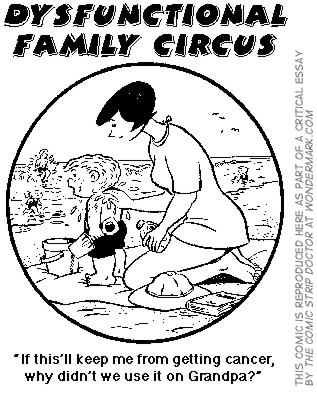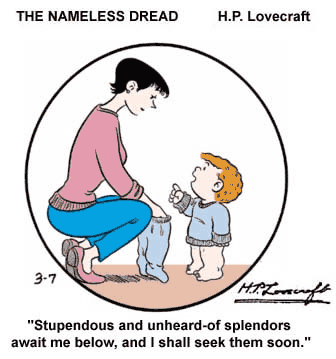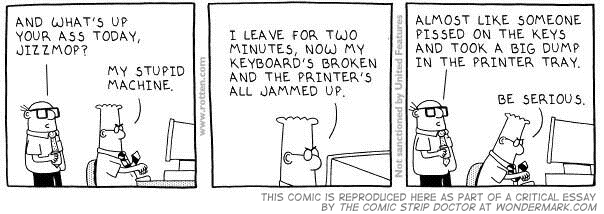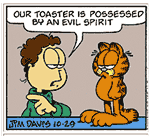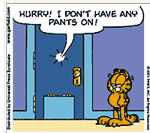
(Click any of the images to zoom in on them.)
Today I’ll be discussing one of the most beloved characters on the comics page: Garfield, the obese narcoleptic. I was always a fan of Garfield, much like many people were probably fans of Beetle Bailey or Crankshaft back in their first few decades, and so it’s as a fan that I feel qualified to comment on the inevitable slide into stupidity (common to all strips) that the 21st century has brought Garfield.
In fact, some would claim that any enjoyment we readers get (or have ever gotten) from Garfield is more than we should, by rights, expect: “Davis meticulously plotted Garfield‘s success,” writes Chris Suellentrop in a revealing Slate article. “And part of his calculation was to make the strip so inoffensive that it’s hard to hate it even for being anodyne.” From the beginning, according to Suellentrop, the Garfield character was conceived as a vehicle for sloganeering, merchandise, and pabulum.
And what suckers we kids were. But I find it hard to believe that there’s never been any creative spark in the strip, and a look through the archives confirms my suspicions:
The above strip, first published on June 28, 1978, featured most of the core ingredients that would evolve into the Garfield mythos: clueless Jon, hungry Garfield, and an assertion of dominance on Garfield’s part. (Ancillary additions such as Odie, Nermal, and the larger cast of supporting characters would appear later.) In short, the strip above roughly defined the character as he would essentially remain.
The following strip was published nearly twenty-six years later, on June 5, 2004:
No, Garfield, we probably won’t.
Above we find an exploration of character similar to the 1978 strip, but lacking dimension. Here, Garfield’s asserting his dominance over Jon, but Jon is a prop rather than a character — he’s quite literally reduced to a chew toy. Creator Jim Davis is content to take the supremely easy way out and leave the joke one-note. In fact, he’s even left the center panel blank, showing us a blank wall and a word balloon instead of the action he wasn’t above drawing in 1978.
This devolution of content, concurrent with the rise of increasingly lazy draftsmanship, is common to all comic strips in their second or third decade of existence. We’ve already examined some strips far beyond this threshold; here we have the opportunity to look back and actually trace the fall of Garfield, as it were.
First published on February 11, 1984, the above strip was one segment of a week-long story involving Jon trying to take Garfield to the vet. Remarkable by today’s standards for involving a set that isn’t the living room or the front yard, this strip includes several novel elements: Jon is going about his life, doing laundry, suggesting that he in fact has a life; there is an ongoing narrative continuity; and Garfield gets a hint of comeuppance. The complexity of the structure shows that at this point, Jim Davis was really coming into his own as a creator.
The above strip, from January 27, 1989, is exemplary of what I would consider Garfield‘s Golden Age. The gag’s humor stems from absurdity but is also firmly rooted in the established character. The Garfield shown above is more apt to be mischievous than his doughy predecessor, and less likely to be smug than his soulless successor.
It was this incarnation of Garfield that the animated show Garfield and Friends brought to television. Bizarre, self-referential, and hallucinogenic, the popular show has recently found a new home on DVD and in syndication on Toon Disney. The show’s concept was rooted in the strip, but it diverged wildly, featuring vivid characters and outlandish plots that occupied a world of their own.
The Garfield and Friends Garfield is the height of the character’s achievement. With the success of the show, the role of merchandising grew, slowly inflating even as its creative basis dwindled, until it would become the bloated whale responsible for Garfield: The Movie.
Originally published August 17, 1996, the above strip is exemplary of what I would call Garfield‘s Silver Age. The absurdity is still present, to a degree, and humor flows naturally from the playful interplay between Garfield’s inflated sense of self-worth and the attempts of the world at large to deflate his ego.
Early on, as Davis was establishing Garfield’s character, it was easy enough to make him a fat cat utterly in charge of his world. As time passed, the characters’ interrelationship grew more complex, and Garfield could be placed into situations where his already-established role would be challenged. In other words, it became funny to subvert the Garfield-in-charge paradigm.
Then, as more time passed, Davis fell into a rut. The strip was more popular than ever; Davis was fielding merchandising offers left and right; he even felt confident dividing his attention, and began devoting time to another comic strip, Mr. Potato Head. Garfield was an unqualified success, and if it ain’t broke, don’t fix it, right?
Well, Mr. Davis, I humbly submit that it is broke. The above strip, published May 22, 2004, is remarkable only for its unremarkableness. This is what Garfield has become: a cat in a living room. And after twenty-six years, why is Jon wondering what happened to his lunch?
The Garfield website, a noisy mess of jangly Flash animation and advertising, does have a couple of things going for it: comprehensive archives (hence the above strips) and a Make-Your-Own-Strip function. To make your own strip, you can combine characters, props, and backgrounds, and write your own dialogue:
Panel 1: Welcome to my living room. It’s the only place I feel safe.
Panel 2: Holy cow! My toothpaste is sitting on the floor!
Panel 3: It’s the most interesting thing that’s happened in years.
It’s only barely an exaggeration to say that the backgrounds available for you to choose from are yellow living room, blue living room and red living room. They can make an elaborate animated Garfield Hunchback opening the vault archives, but they can’t make the text in the Make-Your-Own strip easy to read, nor can you save your creation. The above is a screen capture.
What have you become, Garfield? What happened to being lost in a snowy alley on Christmas (1984)? What happened to Aunt Gussie, and Doc Boy, and even Liz the vet? I wouldn’t even mind a cameo appearance by short-lived mustachioed roommate Lyman if it meant a little variety.
In short, Garfield, like The Wizard of Id, like B.C., has become an institution instead of a comic strip. I’m not knocking the concept of merchandising; Get Fuzzy has merchandise up the wazoo but it’s still the funniest strip in the newspaper. In fact, it wouldn’t be an exaggeration to say that Get Fuzzy is the heir to Garfield‘s throne; the strip, by Darby Conley, revolves around a young homebody’s interactions with his egomaniacal cat and dimwitted dog.
Our goal here, post-diagnosis, is to heal. My prescription for Garfield, barring a complete re-evaluation of what the Garfield comic is, is to bring back the stories, the adventures, the characters that take the cat out of his living room. I know it’s easier to draw a spider than a mailman; it’s easier to draw a table than a sidewalk. But one-note jokes + lazy art = boring, boring, boring.
Here’s a strip from May 11, 2004:
This strip is so one-note it’s embarrassing. My only suggestion to revise this strip would be something akin to the following:
But that’s only marginally better. The solution, it turns out, lies in wholesale recontextualization. Because why shouldn’t we re-evaluate what Garfield is? It’s now a cultural icon more than a storytelling device or a source of humor; there must be a way to capitalize on that familiarity it enjoys with the reader to create something new, different, and funny. As it turns out, there is such a way.
I mentioned earlier how there has been a gradual progression in terms of the way Garfield’s character has been represented: first, it’s funny to show him as a cat in charge of a human; later, it becomes funny to show his role being subverted. Now, since he’s been idling in neutral for a decade, what’s funny is to subvert once again.
The Garfield Randomizer was a short-lived Internet phenomenon that accessed Universal Press Syndicate’s comprehensive Garfield archives to produce new strips out random combinations of panels from different strips. Some results were simply bizarre; most were bizarrely hilarious. Snippets of dialogue combined randomly to create esoteric or oddly subtextual conversations; at other times, awkward silences filled the entire strip. The dada results thoroughly skewered the reader’s well-worn preconceptions of the cadences and rhythms of typical Garfield. (I wrote another column specifically about this concept; also, a gallery of results from the Randomizer can be found here.)
Clearly, the next level for Garfield is the postmodern world. I’ll press “Go” on the Randomizer and leave the rest up to chance.
Until next time, I’ll see you in the funny papers.
— September, 2004 (revised February 2006)
Author’s Note, October 2008: In the years since this article was first written, two things have changed for Garfield. One is that the strip in the newspaper has gotten marginally better; more character development and what seems to be a new gang of gag writers have breathed some much-needed new life into the strip. Secondly, the “Garfield Minus Garfield” phenomenon has proven my diagnosis utterly correct. Legions of fans have rediscovered the surreal potential buried beneath the strip’s overly broad presentation, and the postmodern treatment has invigorated the franchise to a level far beyond what the strip could have accomplished on its own. To his credit, Jim Davis has embraced the concept, and an officially licensed “Garfield Minus Garfield” book is now in the works.












